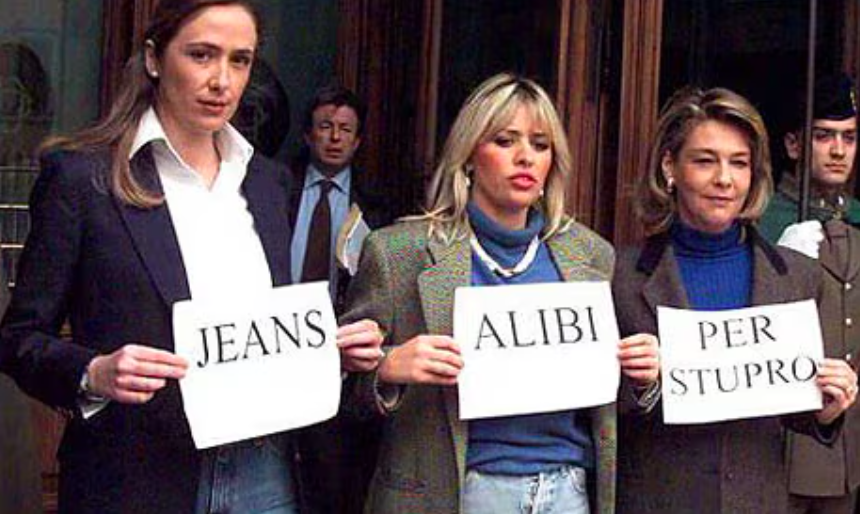Denim Day, Denim Forever by Alexis Norris
Each year on the last Wednesday of April, people wear jeans to honor Sexual Assault Awareness month and stand in solidarity with victims. The campaign stems from a decision made in 1998 by the Italian Supreme Court to overturn a rape conviction on the basis that the victim’s tight jeans were impossible to take off by the attacker unless aided by the wearer herself, implying that the act must have been consensual. This ruling sparked outrage; female Parliament members immediately protested by wearing jeans and holding signs that read “Jeans: An Alibi for Rape.” This case served as a catalyst for sexual assault awareness and activism, initiating the global protest we now call “Denim Day.”
In addition to “Denim Day,” jeans have historically signaled protest in a plethora of other contexts. In the 1960’s, jeans were worn by Black activists to call attention to racial caste and Black poverty, serving as a sartorial symbol of the Civil Rights Movement (Tensley). Furthermore, Hippies embraced denim as their freedom uniform, opposing the Vietnam War, consumerism, and general societal establishment. Various other subcultures have donned denim to express their own rebellious attitudes.
Although jeans have undoubtedly been used to showcase defiance, they have never belonged to just one political persuasion (Tensley). Conservative leaders and followers are known to wear denim regularly, oftentimes pointing to affiliation with rural culture and support of traditional Americana. Additionally, for some people, jeans are nothing more than a classic garment choice.
Contemporarily, denim stands steady in its political roots and simultaneously broadens both creative and critical horizons. Jeans today are styled in an abundance of ways, acting as an archival expression of the various trends and cultural influences accumulated over decades. Moreso, denim is also heavily used to revitalize and redefine styles – most notably, denim patchwork, head-to-toe denim looks, and hyper-recently, joots.
Joots, or jean boots, were popularized following Elsa Hosk’s influential Instagram post of her wearing the $550 ‘Bux Denim Jeans Boot’ by Icelandic footwear brand, Kalda. She made the post in June of 2022, and since then, other luxury brands like Loewe, Isabel Marant, and Dolce and Gabbana have adopted the joots. The designs trickled down into more accessible brands, like Steve Madden, Jeffrey Campbell, and Zara. Beautifully, many wearers took this inspiration that is now bouncing between brands and began to DIY the look. Many people cut the lower legs off their jeans and roll them over their boots, whereas some patchwork the boots with various pieces of old denim. This is a prime perpetuation of denim’s subversiveness; wearers are using their own agency to redesign a commodified product into something uniquely theirs.
Taking one last look back, 1989 Vogue’s editorial shoot titled “Beach Blues” photographed by Ellen Von Unworth reveals how marketable denim’s versatility has always been. This editorial shoot is advertising not only denim items, but full denim looks. Readers are encouraged to purchase denim pants, shirts, vests, coats, skirts, and swimwear. The ad explicitly uses denim’s experimental potential to sell products. The subtitle reads, “designers are experimenting with denim – tailoring it, tucking it, turning it into bikinis.” This message’s sentiment is eternal; denim is consistently used as a tool to experiment, both politically and sartorially. The explorative essence that denim holds is timeless and dynamic, yet wearers are blinded by the conventionalization of the product.
Contrary to its color, denim’s cultural significance will never fade. The recycling of denim symbolism is an exhibition of how wearers can take power into their own hands to emulate something out of reach to them, or to give chronic vision to a worthy movement. As Emma McClendon states in Denim: Fashion’s Frontier, “denim today bridges the gap between high fashion and workwear, past and present, menswear and womenswear, personalization and homogenization.” Denim inherently evokes both nostalgia and progression immortally, transcending fashion.
Tensley, Brandon. “How Denim Became a Political Symbol of the 1960s.” Smithsonian Magazine (December 2020) https://www.smithsonianmag.com/arts-culture/denim-political-symbol-1960s-180976241/#:~:text=In%20the%201960s%2C%20denim%20came,the%20art%20historian%20Caroline%20A.
Von Unwerth, Ellen. “Beach Blues.” Vogue (1989) 374-378
McClendon, Emma. “Denim: Fashion’s Frontier.” The Fashion Institute of Technology (2016) 1-212
